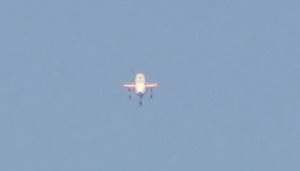Indian Space Research Organisation (Isro) today successfully conducted the Reusable Launch Vehicle Autonomous Landing Mission (RLV LEX). The test was conducted at the Aeronautical Test Range (ATR), Chitradurga, Karnataka in the early hours on 2 April 2023.

The RLV took off at 7:10 am IST with a Chinook helicopter of the Indian Air Force carrying it as an underslung load and flew to a height of 4.5 km (above mean sea level). Once the predetermined pillbox parameters were attained, based on the RLV's mission management computer command, the RLV was released in mid-air, at a down range of 4.6 km.
Release conditions included 10 parameters covering position, velocity, altitude and body rates, etc. The release of RLV was autonomous. RLV then performed approach and landing maneuvers using the Integrated Navigation, Guidance & Control System and completed an autonomous landing on the ATR air strip at 7:40 AM IST. With this, Isro has successfully achieved the autonomous landing of a space vehicle, says a press release.
The autonomous landing was carried out under the exact conditions of a space re-entry vehicle's landing —high speed, unmanned, precise landing from the same return path — as if the vehicle arrives from space. Landing parameters such as ground relative velocity, the sink rate of landing gears, and precise body rates, as might be experienced by an orbital re-entry space vehicle in its return path, were achieved.
The RLV LEX demanded several state-of-the-art technologies, including accurate Navigation hardware and software, pseudolite system, Ka-band radar altimeter, NavIC receiver, indigenous landing gear, aerofoil honey-comb fins and brake parachute system.
Isro also achieved a first when the winged body was carried to an altitude of 4.5 km by a helicopter and released for carrying out an autonomous landing on a runway.
RLV is essentially a space plane with a low lift to drag ratio requiring an approach at high glide angles that necessitated a landing at high velocities of 350 kmph. LEX utilised several indigenous systems. Localized navigation systems based on pseudolite systems, instrumentation, and sensor systems, etc were developed by Isro. Digital Elevation Model (DEM) of the landing site with a Ka-band Radar Altimeter provided accurate altitude information. Extensive wind tunnel tests and CFD simulations enabled aerodynamic characterisation of RLV prior to the flight. Adaptation of contemporary technologies developed for RLV LEX turns other operational launch vehicles of ISRO more cost-effective.
Isro had demonstrated the re-entry of its winged vehicle RLV-TD in the HEX mission in May 2016. The re-entry of a hypersonic sub-orbital vehicle marked a major accomplishment in developing Reusable Launch Vehicles. In HEX, the vehicle landed on a hypothetical runway over the Bay of Bengal. Precise landing on a runway was an aspect not included in the HEX mission. The LEX mission achieved the final approach phase that coincided with the re-entry return flight path exhibiting an autonomous, high speed (350 kmph) landing. The LEX began with an Integrated Navigation test in 2019 and followed multiple Engineering Model Trials and Captive Phase tests in subsequent years.
Along with Isro, IAF, CEMILAC, ADE, and ADRDE contributed to this test. The IAF team hand in hand with the project team conducted multiple sorties to perfect the achievement of release conditions. S Unnikrishnan Nair, director, VSSC, and Shyam Mohan N, programme director, ATSP guided the teams. Jayakumar M, project director, RLV was the mission director, and Muthupandian J, associate project director, RLV was the Vehicle Director for the mission.
With LEX, the dream of an Indian Reusable Launch Vehicle arrives one step closer to reality.
Prime Minister Narendra Modi has expressed happiness at the success of Isro’s Reusable Launch Vehicle Autonomous Landing Mission.
“A great team effort. This achievement takes us one step closer to realising an Indian Reusable Launch Vehicle,” the Prime Minister tweeted in reply to the tweet threads by Isro.































